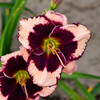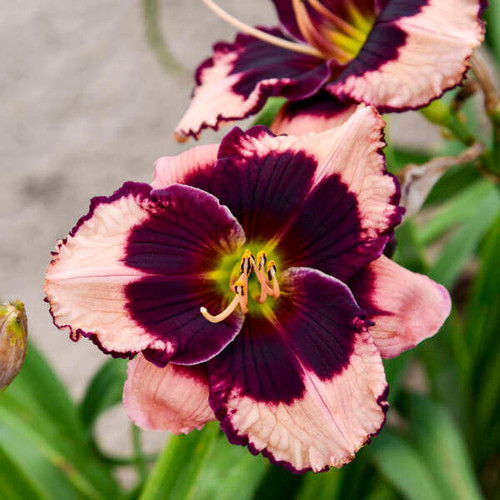Product Description
Hemerocallis 'Jane Trimmer' (25) BR Plants
Common Name: Daylily
5" wide flowers are pale lavender with large purple eyes so dark as to appear black. A matching picotee edge rings the petals. Flower stalks are proportionate to the size of the plant with the flowers held just above the foliage. Early-Midseason bloomer with good rebloom.
Daylilies can survive many harsh conditions that other plants cannot including: polluted city environments, slopes, poor and dry soils, near pavement that is salted in winter, and under Black Walnut trees (not affected by juglone).
- Early-Midseason Bloomer.
- Rebloomer, producing a second set of flowers.
- Evergreen foliage.
- Tetraploid
American Hemerocallis Society Don C. Stevens Award (Best eyed cultivar) -- 2009
American Hemerocallis Society Honorable Mention (AHS first stamp of approval) -- 2005
American Hemerocallis Society Award of Merit (Outstanding beauty and performance over a wide area of the country) -- 2008
Daylilies are some of the easiest perennials to grow and are a good choice for any gardener, from the beginner to the professional. These are tough, adaptable plants that will grow in any soil, from normal to slightly wet to dry. Older varieties are able to bloom if planted in partial shade, but most of the newer introductions need full sun for best performance. Likewise, older varieties tend to spread more rapidly than the newer hybrids.
Plants should be deadheaded for cosmetic purposes, but in most cases this will not extend the bloom time.
Height: 25.0 Inches
Spread: 18.0-24.0 Inches
Hardiness Zones: 3,4,5,6,7,8,9
Flower Color: Pink shades, Purple shades, Multicolored
Full Sun to Part Shade
Low to Average Water Needs
Poor to Fertile Soil Quality
Bloomtime: Midsummer
Attracts Butterflies and Hummingbirds
Bee Friendly
Rabbit Resistant
Growth Rate: Medium
Border Plant, Container, Easy To Grow, Fragrant Flowers, Mass Planting, Salt Tolerant
Jane Trimmer'! This is a truly stunning daylily, and it's no wonder it's a favorite among gardeners. It was hybridized by Dan Trimmer and named after his wife, so you know it had to be special! Here is what makes 'Jane Trimmer' so wonderful:
Appearance:
- Color: The flowers are a captivating pale lavender, which provides a beautiful backdrop for the dramatic, almost black, purple eye and picotee edge. The contrast is simply striking! The dark purple eye extends outwards, creating a bold and eye-catching focal point, while the picotee edge, a thin line of the same dark purple, delicately outlines the petals, adding a touch of refinement.
- Flower Form: The flowers are a good size, around 5 inches wide, with a full, rounded form. The petals are wide and slightly recurved, giving the bloom a classic daylily shape. The overall effect is elegant and sophisticated.
- Size: As mentioned, the flowers are about 5 inches (12 cm) wide, making them a noticeable presence in the garden.
- Height: 'Jane Trimmer' typically grows to around 25 inches (63 cm) tall. This makes it a great choice for the middle of the border, where it can be easily seen without overshadowing other plants.
Growing Information:
- Bloom Time: This daylily is an early to midseason bloomer, and it's also a reliable rebloomer, meaning you'll get multiple waves of flowers throughout the season. This extended bloom time is a major plus, as it allows you to enjoy the beautiful blooms for a longer period.
- Sunlight: Like most daylilies, 'Jane Trimmer' thrives in full sun (at least 6 hours per day), but it can also tolerate some light shade. Full sun will encourage the most profuse blooming, but in very hot climates, some afternoon shade may be beneficial.
- Soil: It is adaptable to various soil types, but it prefers well-drained soil with average moisture. Daylilies are generally low-maintenance, but they will perform best in soil that is rich in organic matter and drains well.
- Watering: Water regularly, especially during dry spells, but avoid overwatering. Daylilies are relatively drought-tolerant once established, but they will appreciate consistent moisture, especially during hot, dry weather.
- Hardiness: 'Jane Trimmer' is hardy in USDA zones 3-9, making it suitable for a wide range of climates.
Other Notable Features:
- Evergreen Foliage: This daylily has evergreen foliage, which means that the leaves will remain green throughout the year in warmer climates, providing a nice ground cover even when the plant is not in bloom.
- Prolific Bloomer: 'Jane Trimmer' is known for its abundant blooms, with each scape (flower stalk) producing numerous flowers. This ensures a spectacular display of color when it is in bloom.
Uses in the Garden:
- Middle of the Border: Its height and striking color combination make it an excellent choice for the middle of the border, where it can act as a focal point.
- Specimen Plant: It can also be planted as a specimen plant, where its unique beauty can be fully appreciated.
- Mass Plantings: 'Jane Trimmer' creates a stunning display when planted in groups, where the mass of lavender and purple blooms can create a dramatic impact.
Additional Tips:
- Deadhead spent flowers to encourage reblooming and maintain a tidy appearance. This will also prevent the plant from self-seeding, which can lead to unwanted seedlings.
- Divide clumps every few years to maintain vigor and prevent overcrowding. This will also help to ensure that the plant continues to produce abundant blooms.
Other Details
The most important part of the plant is its root system. Healthy roots are the foundation of a healthy, vibrant plant. The type of plug container used is based on the specific needs of the plants. Perennials offered as bare root traditionally perform better when planted as bare root.Planted in a specialized mix, potted plants have well established root systems. Top growth stage will vary depending on the current life cycle and time of year when shipped. In Winter and early Spring dormant plants may be shipped. Dormant plants may be planted right away, even before the last frost date.
Most bare root varieties are field grown for at least one season, though Hemerocallis and Hosta are grown for two seasons. The bulk of the soil is removed during the harvesting process and the tops of most varieties are trimmed back to the crown. They are graded, packed in shredded aspen or sphagnum moss and stored in freezers until ready to be shipped.
See our Container Sizes and Bare Root Perennials pages for more information.
Plant information and care is provided in the Overview section, Plant Genus Page and general information is provided in the Planting Care & Guides. Additional questions can be asked on each Plant page.
Plant Spacing: Using the maximum mature spread or width of a plant to guide spacing, ensures space to grow to full size. To fill an area sooner, plant them closer together. Just remember, future thinning or transplanting may be needed.
Water: Keep a close eye on newly planted perennials, especially throughout the first growing year. Most early plant loss is due to too much or too little water!








